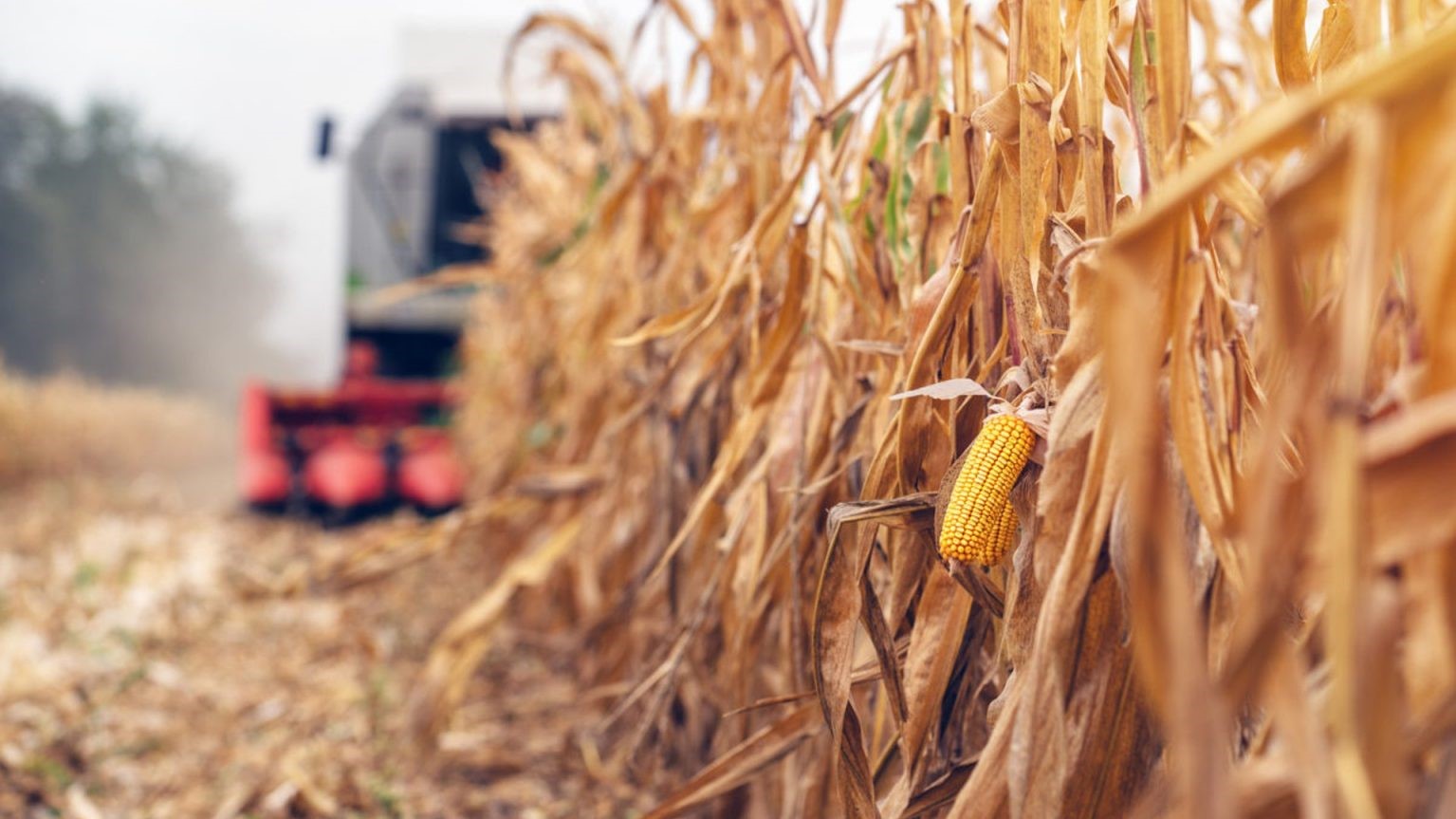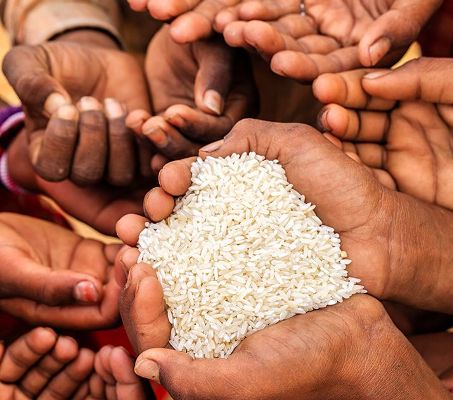
Think about the following questions.
1. What do you think is meant by the term "food security"?
2. Why might some areas of Earth produce less food than others?
3. Which kinds of natural disasters might affect how much food people have?
VOCABULARY PREVIEW
Match each New Academic Word List(NAWL) word with the correct definition.
- breakdown _____
- unstable _____
- stabilize _____
- mechanical _____
- convergence _____
- marginal _____
- a. to stop something changing or getting worse
- b. not fixed or safe and likely to change
- c. small and not significant
- d. two or more things meeting at a particular point
- e. related to or operated by machinery
- f. the failure or end of something
FOOD SECURITY AND FOOD SUPPLY

Being food-secure means having consistent access to enough food, even during natural disasters and economic crises. This can be achieved either through domestic food production or by importing food from abroad. For economic reasons, many in developing countries deal with a lack of food security every day, while for others, it only becomes a concern when disasters such as extreme weather or economic crises strike. Now climate change means that natural disasters are occurring more often, and thanks to globalization, a problem in one country can often affect people worldwide.
Seemingly1 "natural" disasters leave countries like Bangladesh highly unstable in terms of food security. In fact, climate change has left Bangladesh at increased risk of flooding as cyclones become more common and sea levels rise. Located at the convergence of three major rivers, most of Bangladesh is less than five meters above sea level. In 2007, after prolonged2 heavy rain, an estimated 26,500 farm animals were lost to floods, and fish farms a major source of food-were also affected as fish escaped back to sea. Above all, Bangladesh relies on rice, and the 2007 floods destroyed 2.2 million tons of the crop. Furthermore, with road and rail links underwater, it was impossible to distribute the rice that remained. As a result, prices rose sharply. An estimated ten million people were left without access to enough food. In response, the United Nations World Food Programme (WFP) spent $51 million feeding 2.3 million people for six months.
A more long-term solution, the Flood Action Plan, was funded by the World Bank and attempted to build both flood defenses and raised storage units for rice crops. However, the pace of climate change meant that sea levels rose faster than ever before, and many of these measures were ineffective. Bangladesh contributes just 0.3 percent of global carbon emissions but is set to suffer far more from climate change than most nations. It is also relied upon by other countries for manufacturing. Bangladeshi problems are world problems. Nevertheless, by 2020, further floods— alongside political and economic factors-had left twenty-five percent of people in Bangladesh food-insecure.
Another food crisis in 2008 was more obviously global. Droughts in Russia, Ukraine, and Australia led to major crop failures. These countries are major exporters3 of wheat and, without their input, a world shortage occurred. At the same time, oil prices were high due to continued demand from developed countries and increased demand from the developing world. Oil is required for intensive, mechanical agriculture, so producing crops became more expensive, and farmers passed this cost on to consumers. As an alternative to oil, the US began using more of its crops to produce biofuels (fuels made from plants or animals). This seemed like a sustainable solution, but it left even fewer crops for food, creating more scarcity4. Finally, in some developing countries, as populations became larger and wealthier, demand for food grew. So just when crops were needed most, they were in short supply and were expensive to produce; at the peak of the crisis, the prices of wheat and rice rose by almost one hundred percent.
A breakdown of supply followed as some countries imposed export bans and restrictions5; major rice producers like India and Vietnam wanted to ensure they could feed their own populations first. However, these policies tend to drive up prices elsewhere, and often their benefits are marginal, even for the countries which impose them. Wealthier people purchase and hoard6 large quantities of food, a practice known as "panic-buying." Businesses also stockpile7 large amounts of food to sell, creating a black market open to corruption. Prices become even higher and, as it becomes completely unaffordable8, food simply goes to waste. To fight this issue in the Philippines, those found to be hoarding food were subjected to large fines.
By 2018, hundreds of millions of people worldwide were facing severe hunger, and in 2020, COVID-19 compounded the problem as factories shut, transport infrastructures9 broke down, and borders closed. Food prices rose almost twenty percent in one year. By April 2021, the WFP estimated that 296 million people in the thirty-five countries where it worked were undernourished10 - 111 million more people than before the COVID-19 pandemic.
Some countries are far less food-secure than others, but climate change and globalization increasingly mean that national crises are not simply local problems. Furthermore, as governments and organizations try to stabilize food security and ensure food supply, they will have to think carefully about the unintended effects of their initiatives11.
New Academic Word List
- seemingly 1 : adv. appearing to be something, especially when this is not true
- prolonged 2 : adj. continuing for a long time
- exporter3 : n. a person, country, or business that sells goods to another country
- scarcity 4 : n. a lack of something
- restriction 5 : n. an official limit on something
- hoard 6 : v. to collect large amounts of something and keep it for yourself
- stockpile 7 : v. to store a large supply of something for future use
- unaffordable 8 : adj. too expensive for people to be able to pay for
- infrastructure 9 : n. the basic systems that a country uses in order to work effectively
- undernourished10 : adj. not eating enough food to be in good health
- initiative11 : n. a new plan or process to achieve something or solve a problem
READING COMPREHENSION
A ‣ Mark each statement as true (T) or false (F) according to the reading.
- Bangladesh's geography has helped to protect it from the effects of climate change.
- True
- False
- Bangladesh is an important country for producing goods.
- True
- False
- During the 2008 crisis, the US tried to find an alternative food to wheat.
- True
- False
- During crises, richer people often panic-buy food to sell at a profit.
- True
- False
- Due to the COVID-19 pandemic, the number of undernourished people increased by over one hundred million.
- True
- False
B ‣ Choose the best answer according to the reading.
- What does the reading mainly discuss about food?
- a. How it is produced and sold in different countries
- b. The ways it helps countries develop their economies
- c. How crises affect people's ability to access it
- d. What happens when governments fail to provide it
- In paragraph 1, the word domestic is closest in meaning to _____.
- a. external
- b. internal
- c. traditional
- d. modern
- Which of the following factors did NOT contribute to the 2008 food crisis?
- a. Oil spillages
- b. Crop failures
- c. Making biofuels
- d. Increased demand
- What can be inferred from paragraph 5?
- a. The Indian population was stockpiling food for export.
- b. The Vietnamese government worked with India to provide food.
- c. The population in Asia grew more quickly than elsewhere.
- d. The Filipino government wanted to reduce food waste.
C ‣ Fill in the blanks with the information from the reading.
- A number of large _____ meet in Bangladesh, making it vulnerable to flooding.
- _____ were beginning to get wealthier, and their populations wanted more rice and wheat.
- The benefits of export _____ are not significant for the nations that use them.
SUMMARY
Write the number of each sentence under the category it belongs to.
| Food Insecurity | |
| Causes 1 _____ |
Effects 2 _____ |
- Natural disasters like floods and droughts lead to the destruction of crops.
- The production of biofuels uses up crops that could be used to feed humans.
- In Bangladesh, ten million people do not have access to sufficient food.
- Due to crop failures and the cost of oil, prices rise, and people cannot afford to purchase food.
- Governments impose export bans to try and protect their populations' access to food, and aid agencies deliver food.
- In 2018, hundreds of millions of people across the planet did not have enough food.
VOCABULARY PRACTICE
Fill in the blanks with the words in the box. Change the form if necessary.
- marginal
- stabilize
- mechanical
- unstable
- convergence
- breakdown
- Governments sometimes print more money to _____ their economies.
- Wars are often caused by a(n) _____ in communications between countries.
- The nutritional benefits of some popular breakfast cereals are _____ at best.
- Unfortunately, the airplane's departure was delayed due to a(n) _____ problem.
- The _____ of several political and economic factors led to the Great Depression of the 1930s.
- The country's political system is as _____ as a chair with two legs.
SUPPLEMENTAL READING
Nepal: Food after the Earthquakes

In 2015, a series of huge earthquakes struck Nepal, killing over 8,800 people. After the initial destruction to buildings, lack of food security presented a longer-term threat to Nepali citizens.
Even before the earthquake, up to seventy percent of people in mountainous areas were classified as having poor or unreliable access to food. In these remote locations, stocks of grain are typically stored in people's homes. This meant that thanks to the earthquakes, eighty percent of households in the worst-affected areas lost their entire stocks of food. Even those with enough money to replace lost food found that they could not access markets in towns, as transport connections were broken by destroyed roads or landslides.
Some 3.5 million people found themselves needing food assistance. UN agencies, including the WFP and UNICEF-the UN's children's agency-launched a $415 million appeal. Initially, UN helicopters dropped high-energy biscuits to help those in immediate need, but with time, they brought more than 2,000 tons of food into the country, much of it having been sent from neighboring India. The Red Cross also raised $26 million and used these funds to distribute much-needed food and water.
Although food aid helped Nepal through one of its darkest hours, by 2021, 4.6 million people remained food-insecure, and the Red Cross was still on the ground. In fact, research by USAID showed that ten percent of homes were severely food-insecure.
Improving Nepal's infrastructure may be the best way to increase—and, most importantly, stabilize-food security. As things stand, farmers have little access to quality seeds or up-to-date agricultural technologies. Transport links also remain limited in this relatively small and incredibly mountainous country. Helping countries like Nepal requires global investment before, not after, disasters like the 2015 earthquakes.
Fill in the blanks with information from the reading.
- Before 2015, in _____ parts of Nepal, seventy percent of people did not have enough access to food.
- _____ is the UN organization that helps young people who are in need.
- In 2021, the problem continued to be so great that _____ was still in Nepal.

Leave a comment
Load more